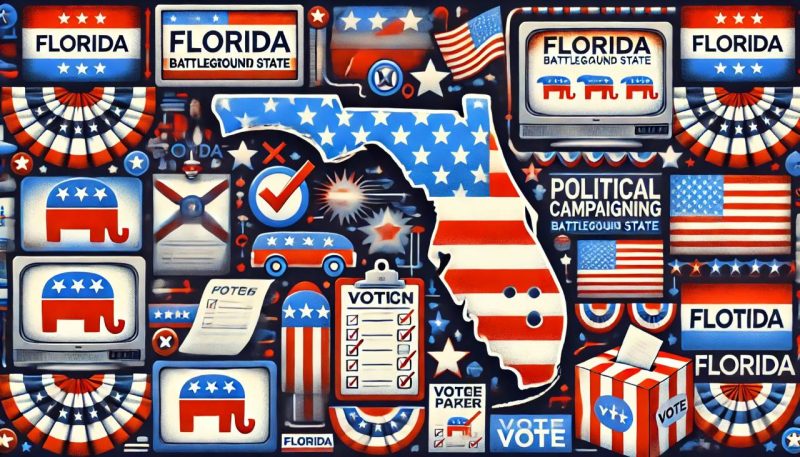
Trump needs Florida to win. The Floridaman would seem to be running scared as his campaign has put money into a state that was seen before now as unwinnable for the Democrats.
Florida remains a critical state, one that can tip the scales in a presidential election. Former President Donald Trump, well aware of Florida’s significance for him to have any chance, has ramped up his television advertising spending in the state. This move comes as Vice President Kamala Harris gains momentum and increases her visibility, posing a potential challenge to Trump’s influence in this key region. As we approach the next election cycle, these developments suggest an intensifying battle for voters in the Sunshine State.
Florida: A Crucial Battleground State
Florida’s importance in national elections cannot be overstated. With 30 electoral votes, it is the third-largest state by electoral count, following only California and Texas. Historically, Florida has been a swing state, with both Democrats and Republicans vying fiercely for its support. The state’s diverse population, which includes a significant number of Latino voters, retirees, and suburban residents, makes it a microcosm of the broader American electorate. Winning Florida often signals a broader appeal and can set the tone for the rest of the nation.
For Trump, who calls Florida home after moving his official residence there in 2019, the state represents a critical stronghold. He won Florida in both the 2016 and 2020 elections, solidifying his base among its voters. However, the political dynamics in Florida are constantly evolving, and recent polling suggests that Harris is making significant inroads, prompting Trump to step up his campaign efforts.
Kamala Harris’s Rising Popularity in Florida
Vice President Kamala Harris has been increasingly visible in Florida, focusing on issues that resonate with key voter groups. Harris’s engagement with communities of color, young voters, and women has helped boost her profile. She has made multiple visits to the state, addressing issues such as climate change, healthcare, and economic inequality—topics that are high on the agenda for many Floridians.
Harris’s outreach efforts have also included addressing the concerns of Florida’s large Latino population. With her ability to connect with diverse communities, Harris is seen as a formidable figure capable of challenging the Republican hold on Florida. Her increasing popularity is evident in recent polls, which show her approval ratings on the rise, a factor that likely influenced Trump’s decision to increase his advertising spending.
Trump’s Strategy: Doubling Down on TV Ads
In response to Harris’s surging popularity, Trump has significantly increased his television ad spending in Florida. This strategy is aimed at reinforcing his presence and reminding voters of his policies and achievements during his tenure as president. The ads focus on themes central to Trump’s political brand: strong borders, economic growth, and tough stances on crime and immigration.
By increasing his ad spending, Trump aims to solidify his base while also reaching undecided voters. The ads are strategically placed to target key demographics, including older voters and suburban residents, who are critical to winning Florida. Trump’s campaign understands that maintaining a strong media presence is essential to countering Harris’s growing influence and keeping Florida in the Republican column.
The Impact of TV Advertising on Voter Behavior
Television advertising remains one of the most effective tools in shaping voter perceptions and behavior. In a state like Florida, where the electorate is diverse and spread out, TV ads can reach millions of viewers simultaneously, delivering targeted messages that resonate with specific concerns. For Trump, increasing TV ad spending is a way to directly communicate with voters, bypassing traditional media channels that he often criticizes as biased.
However, the effectiveness of TV ads also depends on the messaging and the political climate. Ads that highlight economic achievements, promises of job creation, and tough stances on crime may appeal to Florida’s voters, who prioritize economic stability and safety. At the same time, any missteps or negative ads could backfire, especially if they are seen as overly aggressive or out of touch with voters’ concerns.
A Sign of Things to Come?
Trump’s decision to ramp up TV ad spending in Florida may be a harbinger of an intense and competitive election cycle. It underscores his recognition of Florida’s importance and his willingness to invest heavily to secure victory. For Harris, the increased attention from Trump is a sign that her efforts are paying off, highlighting her potential to challenge Republican dominance in the state.
As both sides prepare for the upcoming elections, Florida will continue to be a focal point. The state’s voters can expect to see a barrage of ads, rallies, and campaign events as Trump and Harris vie for their support. The outcome in Florida could very well determine the trajectory of the 2024 presidential race, making it a must-watch state in the months ahead.
Conclusion: The Battle for Florida Intensifies
The battle for Florida is heating up, with Trump’s increased ad spending signaling a concerted effort to maintain his influence in the state. At the same time, Kamala Harris’s rising popularity points to a competitive landscape where both parties must fight hard for every vote. As we move closer to the next election, Florida will undoubtedly play a crucial role in shaping the future of American politics.
In this high-stakes environment, both candidates will need to navigate Florida’s complex electorate carefully, balancing appeals to their base with efforts to win over undecided and swing voters. The strategies they employ, from TV ads to on-the-ground campaigning, will be critical in determining who ultimately captures the Sunshine State and its all-important electoral votes.
